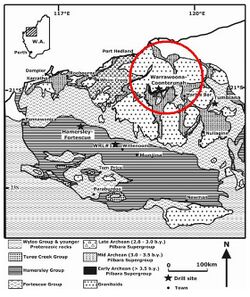Earth:Warrawoona Group
| Warrawoona Group Stratigraphic range: Paleoarchean ~3465 Ma | |
|---|---|
 Warrawoona and Western Australia showing geological classification | |
| Type | Geological group |
| Unit of | Pilbara Supergroup |
| Lithology | |
| Primary | Chert |
| Other | Archean felsic volcanic rocks |
| Location | |
| Coordinates | [ ⚑ ] : 21°42′S 118°0′E / 21.7°S 118°E |
| Region | Western Australia |
| Country | |
| Extent | Pilbara craton |
| Type section | |
| Named for | Warrawoona |
| Named by | Arthur Hugh Hickman |
| Year defined | 1983 |
| Lua error in Module:Location_map/multi at line 27: Unable to find the specified location map definition: "Module:Location map/data/Western Australia" does not exist. | |
The Warrawoona Group is a geological unit in Western Australia containing putative fossils of cyanobacteria cells. Dated 3.465 Ga, these microstructures, found in Archean chert, are considered to be the oldest known geological record of life on Earth.[1][2][3]
Description
The fossils in this group were discovered by Arthur Hugh Hickman in 1983 in Warrawoona, [ ⚑ ] 21°42′S 118°0′E / 21.7°S 118°E, a region on the Pilbara craton in the northern part of Pilbara province.
Whether or not the fossils were authentic was disputed in the past, as abiotic processes could not be ruled out.[4][5] Currently the fossils are thought to be of biological origin, however there is no conclusive evidence of fossilized organisms in the formation, and whether the lines in the rock are fossilized stromatolites.[6]
The rocks also include felsic volcanic rocks.[7]
See also
- North Pole, WA for similar issues
- Origin of life
- Timetable of the Precambrian
- Geology of Australia
- Fig Tree Formation
References
- ↑ Skrzypczak, A.; Derenne, S.; Robert, F.; Binet, L.; Gourier, D.; Rouzard, J.-N.; Clinard, C. (March 2004). "Characterization Of The Organic Matter In An Archean Chert (Warrawoona, Australia)". 35th Lunar and Planetary Science Conference. League City, TX. Bibcode: 2004LPI....35.1241S. http://www.lpi.usra.edu/meetings/lpsc2004/pdf/1241.pdf.
- ↑ Derenne, S.; Robert, F.; Skrzypczak-Bonduelle, A.; Gourier, D.; Binet, L.; Rouzaud, J.-N. (July 2008). "Molecular evidence for life in the 3.5 billion year old Warrawoona chert". Earth and Planetary Science Letters 272 (1–2): 476–480. doi:10.1016/j.epsl.2008.05.014. Bibcode: 2008E&PSL.272..476D.
- ↑ Schopf, J. W.; Packer, B. M. (September 1986). "Newly discovered early Archean (3.4–3.5 Ga Old) microorganisms from the Warrawoona Group of Western Australia". Origins of Life and Evolution of the Biosphere 16 (3–4): 339–340. doi:10.1007/BF02422059. Bibcode: 1986OrLi...16..339S.
- ↑ Brasier, M. D.; Green, O. R.; Jephcoat, A. P.; Kleppe, A. K.; Van Kranendonk, M. J.; Lindsay, J. F.; Steele, A.; Grassineau, N. V. (March 2002). "Questioning the evidence for Earth's oldest fossils". Nature 416 (6876): 76–81. doi:10.1038/416076a. PMID 11882895. Bibcode: 2002Natur.416...76B.
- ↑ Hofmann, H. J. (June 2004). "Archean Microfossils and Abiomorphs". Astrobiology 4 (2): 135–136. doi:10.1089/153110704323175115. PMID 15253835. Bibcode: 2004AsBio...4..135H.
- ↑ Wacey, D.; Kilburn, M. R.; Saunders, M.; Cliff, J.; Brasier, M. D. (August 2011). "Microfossils of sulphur-metabolizing cells in 3.4-billion-year-old rocks of Western Australia". Nature Geoscience 4 (10): 698–702. doi:10.1038/ngeo1238. Bibcode: 2011NatGe...4..698W.
- ↑ DiMarco, Michael J.; Lowe, Donald R. (August 1989). "Stratigraphy and sedimentology of an early Archean felsic volcanic sequence, eastern Pilbara Block, Western Australia, with special reference to the Duffer Formation and implications for crustal evolution". Precambrian Research 44 (2): 147–169. doi:10.1016/0301-9268(89)90080-6. Bibcode: 1989PreR...44..147D.
Further reading
- Buick, R.; Groves, D. I.; Dunlop, J. S. R.; Lowe, D. R. (February 1995). "Abiological origin of described stromatolites older than 3.2 Ga: Comment and Reply". Geology 23 (2): 191–192. doi:10.1130/0091-7613(1995)023<0191:AOODSO>2.3.CO;2. Bibcode: 1995Geo....23..191B.
- Condie, K. C. (1981). Archean Greenstone Belts. 3. New York City: Elsevier Scientific Publishing Company. ISBN 0-444-41854-7.
External links
 |

